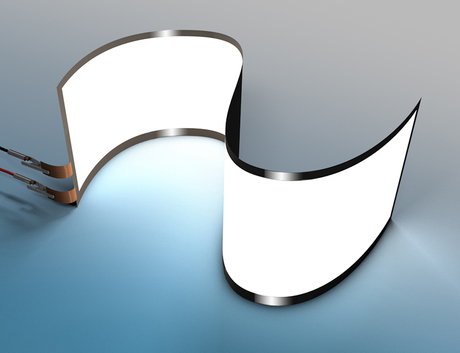Flexible glass for flexible electronics

German technology companies SCHOTT AG, tesa SE and VON ARDENNE GmbH have formed a consortium, KONFEKT, to develop new technologies for the use of glass on roll in organic electronics.
The goal of the consortium, supported by the German Federal Ministry of Education and Research, is to refine windable glass through lamination with functional adhesive tapes and by applying special functional layers. This will hopefully result in a process-ready rolled substrate that offers unique properties for many applications.
The three partner companies are focusing on two features of thin glass: the first subproject features the development of a laminate made of ultrathin glass with a barrier adhesive tape that will serve as a hermetic encapsulation of electronic components. The second subproject will centre on ways that ultrathin glass can serve as a functional substrate for demanding applications, such as components for organic electronics.
In subproject one, SCHOTT and tesa are working to protect sensitive electronic components such as OLEDs (organic light-emitting diodes) from humidity and oxygen by using ultrathin glass. Reliable encapsulation will protect the sensitive components from ageing.
Flexible glass is well suited as a top ultra-barrier (z barrier) because it forms a chemically impermeable layer that is impenetrable to water vapour and oxygen, even at a thickness of 10 micrometres, and does not feature pinholes.
tesa’s expertise as a developer of specialty adhesive tapes comes into play in lateral sealing. The ultrathin glass will be delivered to the user laminated with a special adhesive layer. This adhesive layer ensures that the components are not only sealed hermetically by the glass on their surface, but also experience no lateral diffusion of liquids and gases (x/y barrier).
The combination of the two high-tech materials - specialty glass and barrier tape - provides complete protection, thanks to the functional x/y/z barrier. This roll application will provide processing companies with a high-quality and cost-effective sealing process.
In the second subproject, the equipment manufacturer VON ARDENNE is developing a vacuum coating system specifically for roll-to-roll (R2R) coating of flexible glasses that will meet the special handling requirements of such glasses. Thin glass can thus be used as a functional substrate in sophisticated electronic applications. For example, a conductive TCO layer (transparent conductive oxide) such as ITO (indium tin oxide) is applied in a special vacuum-based PVD (physical vapour deposition) coating process in the same manner as in the manufacture of OLEDs or (organic) photovoltaic cells.
“We expect the consortium to play an important role in the next three years in the development of a new production platform based on glass on roll for innovative use in manufacturing electronic components,” said SCHOTT Director of Business Development for Ultra-Thin Glass Dr Ruediger Sprengard. The project is supported by the German Federal Ministry of Education and Research.
Spinning, twisted light could power next-generation electronics
Researchers have created an organic semiconductor that forces electrons to move in a spiral...
Improving the way flash memory is made
Researchers are developing the ideal manufacturing process for a type of digital memory known as...
Optical memory unit boosts processing speed
Researchers have developed a fast, versatile volatile photonic memory that could enhance AI,...






